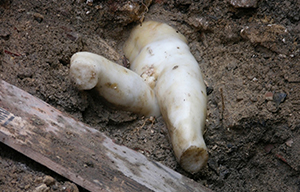Τόμος 3, Τεύχος 2 Μάιος - Αύγουστος 2019
Αρχαιολογική έρευνα και μελέτη στους Κήπους Σαλλαλάτ της Αλεξάνδρειας
Καλλιόπη Λιμναίου-Παπακώστα
Αρχαιολόγος, Διευθύντρια Ελληνικού Ινστιτούτου Έρευνας Αλεξανδρινού Πολιτισμού
 Το Ελληνικό Ινστιτούτο Έρευνας Αλεξανδρινού Πολιτισμού (Ε.Ι.Ε.Α.Π.) ξεκίνησε το 2007 ανασκαφική έρευνα και μελέτη της αρχαίας τοπογραφίας της Αλεξάνδρειας στους Κήπους Σαλλαλάτ, ανασκαφή που συνεχίζεται μέχρι σήμερα. Αυτή η ελληνική ανασκαφή έχει φέρει στο φως αξιόλογα ευρήματα και στοιχεία, που προσφέρουν πολλά στη γνώση της ιστορίας και τοπο-γραφίας της ελληνιστικής και ρωμαϊκής Αλεξάνδρειας. Μεταξύ των ευρημάτων είναι ένα μοναδικής τέχνης, μαρμάρινο άγαλμα, που χρονολογείται στην πρώιμη Ελληνιστική περίοδο, με χαρακτηριστικά της εικονογρα-φίας του Μ. Αλεξάνδρου, η θεμελίωση μνημειώδους ελληνιστικού δημόσιου κτηρίου και μεγάλο τμήμα ρωμαϊκής οδικής αρτηρίας· επίσης, πολλά αρχιτεκτονικά μέλη, τμήμα ρωμαϊκού ψηφιδωτού, άφθονη κεραμική και πολλά νομίσματα. Η ανασκαφή είναι σε εξέλιξη και, βάσει των αποτελεσμάτων πρόσφατης γεωφυσικής έρευνας, στόχος είναι να επεκταθεί η έρευνα και σε άλλα σημεία του πάρκου.
Το Ελληνικό Ινστιτούτο Έρευνας Αλεξανδρινού Πολιτισμού (Ε.Ι.Ε.Α.Π.) ξεκίνησε το 2007 ανασκαφική έρευνα και μελέτη της αρχαίας τοπογραφίας της Αλεξάνδρειας στους Κήπους Σαλλαλάτ, ανασκαφή που συνεχίζεται μέχρι σήμερα. Αυτή η ελληνική ανασκαφή έχει φέρει στο φως αξιόλογα ευρήματα και στοιχεία, που προσφέρουν πολλά στη γνώση της ιστορίας και τοπο-γραφίας της ελληνιστικής και ρωμαϊκής Αλεξάνδρειας. Μεταξύ των ευρημάτων είναι ένα μοναδικής τέχνης, μαρμάρινο άγαλμα, που χρονολογείται στην πρώιμη Ελληνιστική περίοδο, με χαρακτηριστικά της εικονογρα-φίας του Μ. Αλεξάνδρου, η θεμελίωση μνημειώδους ελληνιστικού δημόσιου κτηρίου και μεγάλο τμήμα ρωμαϊκής οδικής αρτηρίας· επίσης, πολλά αρχιτεκτονικά μέλη, τμήμα ρωμαϊκού ψηφιδωτού, άφθονη κεραμική και πολλά νομίσματα. Η ανασκαφή είναι σε εξέλιξη και, βάσει των αποτελεσμάτων πρόσφατης γεωφυσικής έρευνας, στόχος είναι να επεκταθεί η έρευνα και σε άλλα σημεία του πάρκου.
Λέξεις ευρετηρίου: Ε.Ι.Ε.Α.Π., Πτολεμαϊκή Αλεξάνδρεια, Κήποι Σαλλαλάτ, Ελληνιστική Τέχνη, Μέγας Αλέξανδρος, πορτρέτο, ρωμαϊκό μωσαϊκό
COPYRIGHT: © Θέματα Αρχαιολογίας, 2019 - ISSN 2653-9292
Επικοινωνία με την συγγραφέα:
Το πρωτότυπο άρθρο βρίσκεται στη βιβλιοθήκη του περιοδικού Θέματα Αρχαιολογίας
![]()
Αυτό το άρθρο χορηγείται με άδεια Creative Commons Αναφορά Δημιουργού-Μη Εμπορική Χρήση-Όχι Παράγωγα Έργα 4.0 Διεθνές .
Volume 3, Issue 2 May - August 2019
Archaeological Research and Study of the Topography of Shallalat Gardens in Alexandria
Calliope Limneou-Papakosta
Archaeologist, Director of Hellenic Research Institute of Alexandrian Civilization
 The Hellenic Research Institute of Alexandrian Civilization (H.R.I.A.C.) started an archaeological survey at Shallalat Gardens of Alexandria in 2007.This area was considered to be empty of antiquities. However, its position in the topography of Ptolemaic Alexandria was very important, as it was a part of the Royal Quarter, according to the ancient sources and especially Strabo. The excavation was held in the NW side of the park. On May 2009, a unique work of art, an early Hellenistic marble statue was discovered. The type of the statue, its features and attributes of the head, the pose of the neck, the proportions and the movement are elements which suggest the connection of it to the portraiture of Alexander the Great. In autumn 2015 in the same area, in a depth of 10, 00 m, big stones of white limestone were uncovered, that possibly belonged to the foundation of a monumental public Hellenistic building of the Royal Quarter. The next years, a lot of finds were revealed, among which, a hydraulic Roman structure, with a tunnel under it, many later constructions, a part of a Roman mosaic, and, the most important, a big part of a Roman road of 4th century A.D. This road has been already documented as the L2 Street of the map of Mahmud Bey El Falaki of ancient Alexandria. The excavation is in progress and the research will be expanded in more areas of Shallalat Gardens.
The Hellenic Research Institute of Alexandrian Civilization (H.R.I.A.C.) started an archaeological survey at Shallalat Gardens of Alexandria in 2007.This area was considered to be empty of antiquities. However, its position in the topography of Ptolemaic Alexandria was very important, as it was a part of the Royal Quarter, according to the ancient sources and especially Strabo. The excavation was held in the NW side of the park. On May 2009, a unique work of art, an early Hellenistic marble statue was discovered. The type of the statue, its features and attributes of the head, the pose of the neck, the proportions and the movement are elements which suggest the connection of it to the portraiture of Alexander the Great. In autumn 2015 in the same area, in a depth of 10, 00 m, big stones of white limestone were uncovered, that possibly belonged to the foundation of a monumental public Hellenistic building of the Royal Quarter. The next years, a lot of finds were revealed, among which, a hydraulic Roman structure, with a tunnel under it, many later constructions, a part of a Roman mosaic, and, the most important, a big part of a Roman road of 4th century A.D. This road has been already documented as the L2 Street of the map of Mahmud Bey El Falaki of ancient Alexandria. The excavation is in progress and the research will be expanded in more areas of Shallalat Gardens.
Key words: H.R.I.A.C., Ptolemaic Alexandria, Shallalat Gardens, Hellenistic Art, Alexander the Great, portraiture, Roman mosaic
COPYRIGHT: © Themes in Archaeology, 2019 - ISSN 2653-9292
Author for correspondence:
The original article is in the Library of the Themes in Archeology
![]() Creative Commons Attribution-NonCommercial-NoDerivatives 4.0 International .
Creative Commons Attribution-NonCommercial-NoDerivatives 4.0 International .
Διαβάστε το άρθρο Ανάτυπο PDF
Το πρωτότυπο άρθρο βρίσκεται στη βιβλιοθήκη του περιοδικού Θέματα Αρχαιολογίας
![]() Αυτό το άρθρο χορηγείται με άδεια Creative Commons Αναφορά Δημιουργού-Μη Εμπορική Χρήση-Όχι Παράγωγα Έργα 4.0 Διεθνές .
Αυτό το άρθρο χορηγείται με άδεια Creative Commons Αναφορά Δημιουργού-Μη Εμπορική Χρήση-Όχι Παράγωγα Έργα 4.0 Διεθνές .
